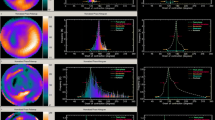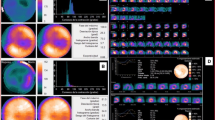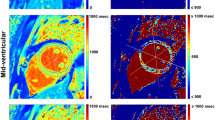Abstract
To detect and quantify consistent ECG amplitude changes, the “ECG variability contour” (EVC) method was proposed. Using this method we investigated amplitude changes in subjects undergoing myocardial perfusion imaging (MPI) with Dipyridamole (Dp). Fifty-three patients having reversible perfusion defects and 19 normal subjects (NS) who were free of: perfusion defects on their MPI, standard ST–T changes during Dp stress, and a negative clinical follow up. Mean ∏ 1 (〈∏ 1〉) was similar for the NS and patient group (6.2 ± 6.1 vs. 6.3 ± 6.2, P = 0.95). 〈∏ 1〉 was 4.6 ± 3.0 in patients not having ST–T changes during Dp stress (n = 42), whereas in patients having ST–T changes (n = 11) it was 13.1 ± 10.2 (P < 0.001). For both groups 〈∏ QRS〉 was smaller than 〈∏ ST〉, which in turn was smaller than 〈∏ T〉. The values of 〈∏ QRS〉, 〈∏ ST〉, and 〈∏ T〉 for the NS, patients without and with ST–T changes were: 26.8 ± 28.6, 42.6 ± 41.8, 44.9 ± 36.5; 19.6 ± 20.8, 26.4 ± 31.4, 38.7 ± 27.3; 51.0 ± 30.0, 71.0 ± 36.8, 75.1 ± 20.9, respectively (P < 0.05 for all comparisons of patients with versus without ST–T changes). This study showed that Dp stress, with or without hypoperfusion, had a clear effect on myocyte electrophysiology, expressed by consistent ECG amplitude changes, detected by the EVC method. The EVC method did not distinguish between NS and patients in this clinical setting.




Similar content being viewed by others
References
Abboud S, Cohen RJ, Selwyn A, Ganz P, Sadeh D, Friedman PL (1987) Detection of transient myocardial ischemia by computer analysis of standard and signal-averaged high-frequency electrocardiograms in patients undergoing percutaneous transluminal coronary angioplasty. Circulation 76:585–596
Becker A, Erel J, Pinchas A, Abboud S (1996) Spectral analysis of the high resolution QRS complex during exercise-induced ischemia. Ann Noninvasive Electrocardiol 1:386–392
Belardinelli L, Shryock JC, Song Y, Wang D, Srinivas M (1995) Ionic basis of the electrophysiological actions of adenosine on cardiomyocytes. FASEB J 9:359–365
Cerqueira MD, Weissman NJ, Dilsizian V, Jakobs AK, Kaul S, Lasky WK, Pennell DJ, Rumberger JA, Ryan T, Verani MS (2002) Standardized myocardial segmentation and nomenclature for tomographic imaging of the heart. Circulation 105:539–542
Dori G, Bitterman H (2008) ECG variability contour—a reference for evaluating the significance of amplitude ECG changes in two states. Physiol Meas 29:989–997
Dori G, Denekamp Y, Fishman S, Rosenthal A, Lewis BS, Bitterman H (2002) Evaluation of the phase-plane ECG as a technique for detecting acute coronary occlusion. Int J Cardiol 84:161–170
Dori G, Denekamp Y, Fishman S, Rosenthal A, Frajewicki V, Lewis BS, Bitterman H (2004) Noninvasive computerized detection of acute coronary occlusion. MBEC 42:294–302
Dori G, Rosenthal A, Fishman S, Denekamp Y, Lewis BS, Bitterman H (2005) Changes in the slope of the first major deflection of the ECG complex during acute coronary occlusion. Comput Biol Med 35:299–309
Dori G, Gershinsky M, Ben-Haim S, Lewis BS, Bitterman H (2009) Evaluating rest ECG amplitude changes using the ECG variability contour method. Proc IEEE Comput Cardiol 36:837–840
Dori G, Gershinsky M, Ben-Haim S, Lewis BS, Bitterman H (2010) Changes in the initial slope of the QRS in ischemic patients and normal subjects undergoing scintigraphy with dipyridamole. Comput Biol Med 40:869–875
Goldberger AL (2008) Electrocardiography. In: Fauci AS, Braunwald E, Kasper DL, Hauser SL, Longo DL, Jameson LJ, Loscalzo J (eds) Harrison’s principles of internal medicine. McGraw-Hill, New York, pp 1393–1395
Hagerman I, Nowak J, Svedenhag J, Nyquist O, Sylven C (1996) Beat-to-beat QRS amplitude variability during dobutamine infusion in patients with coronary artery disease. Cardiology 87:161–168
Hagerman I, Berglund M, Svedenhag J, Nowak J, Sylven C (1996) Beat-to-beat QRS amplitude variability after acute myocardial infarction and coronary artery bypass grafting. Am J Cardiol 77:927–931
Lerman BB, Belardinelli L (1991) Cardiac electrophysiology of adenosine. Basic and clinical concepts. Circulation 83:1499–1508
Michaelides AP, Triposkiadis FK, Boudoulas H, Spanos AM, Papadopoulus PD, Kourouklis KV, Toutouzas PK (1990) New coronary artery index based on exercise-induced QRS changes. Am Heart J 120:292–302
Mirvis DM, Goldberger AL (2008) Electrocardiography. In: Libby P, Bonow RO, Mann DL, Zipes DP, Braunwald E (eds) Braunwald’s heart disease a textbook of cardiovascular medicine. Saunders Elsevier, Philadelphia, pp 149–190
Peuyo E, Sornmo L, Laguna P (2008) QRS slopes for detection and characterization of myocardial ischemia. IEEE Trans Biomed Eng 55:468–477
Shen WK, Kurachi Y (1995) Mechanisms of adenosine-mediated actions on cellular and clinical cardiac electrophysiology. Mayo Clin Proc 70:274–291
Sylven C, Hagerman I, Ylen M, Nyquist O, Nowak J (1994) Variance ECG detection of coronary artery disease—a comparison with exercise stress test and myocardial scintigraphy. Clin Cardiol 17:132–140
Udelson JE, Dilsizian V, Bonow RO (2008) Nuclear cardiology. In: Libby P, Bonow RO, Mann DL, Zipes DP, Braunwald E (eds) Braunwald’s heart disease a textbook of cardiovascular medicine. Saunders Elsevier, Philadelphia, pp 361–366
Zar JH (1984) Biostatistical analysis, 2nd edn. Prentice Hall, Englewood Cliffs, pp 138–145
Acknowledgment
This research was supported in part by the Ministry of Health of Israel.
Author information
Authors and Affiliations
Corresponding author
Rights and permissions
About this article
Cite this article
Dori, G., Gershinsky, M., Ben-Haim, S. et al. “ECG variability contour” method reveals amplitude changes in both ischemic patients and normal subjects during Dipyridamole stress: a preliminary report. Med Biol Eng Comput 49, 1311–1320 (2011). https://doi.org/10.1007/s11517-011-0835-y
Received:
Accepted:
Published:
Issue Date:
DOI: https://doi.org/10.1007/s11517-011-0835-y




